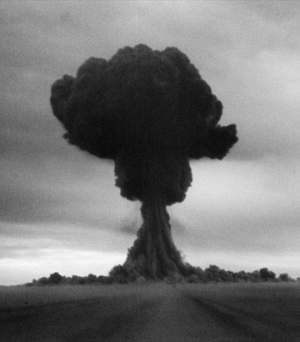
Russia's first nuclear test, Operation Joe
Lightning.
The bomb, named Joe-1 by the West, was
detonated
at the Semipalatinsk Test Site in Kazakhstan in
1949.
Its estimated yield was about 22 kilotons. The
bomb
dropped by the U.S. on Nagasaki, Fat Man, had a
yield of about 21 kilotons.
Vedomosti, Russia
Soviet Theft of American Nuclear Secrets Was Fully Justified
"Had
the Soviet Union failed to learn the secret of nuclear weapons, the alternative
would have been the American nuclear bombing of our country."
By Igor Korotcheko*

Translated By Yekaterina
Blinova
August 29, 2009
Russia -
Vedemosti - Original Article (Russian)
It's been 60 years
since the Soviet Union tested its first atomic bomb. This happened on August
29, 1949 at the Semipalatinsk
test site. Today it's hard to believe that only four years after the end of
the Great Patriotic
War [World War II], we succeeded in achieving such a monumental scientific
and technological breakthrough, having created in such a short time - in
contemporary terms it was just a single presidential term - the industrial infrastructure
to build and test. This is the practical meaning of the term “authoritarian
modernization!” But at the same time, Russia has obviously missed some of the chances
it had in the recent “fat” years for oil and gas.
The decision to launch the
project was made personally by Joseph Stalin, who appointed the first
administrator of the Soviet nuclear project, Lavrenti Beria, who held
the rank of supervisor of Top Secret Special Committee #1 at the USSR Sovmin
(Council
of Ministers). In this capacity, Beria proved himself, without
exaggeration, an exceptional organizer. Of course, applying such a statement in
relation to Lavrenti Pavlovich will provoke a barrage of criticism. Historical
stereotypes are tenacious. He is too ambiguous a figure. But, those who think
that shouting and threats of the gulag can force
nuclear physicists to work effectively are profoundly mistaken.
[Editor's Note: The 'ambiguity' the author refers to is the fact that Lavrenti Pavlovich was a leading official in the NKVD during the "Great Purge," and was responsible for millions of imprisonments and killings of "counter-revolutionaries" - a great tool for score-settling. At the end of the Purge he became NKVD chief (1936–1938) and purged the NKVD itself.]


Fathers
of the Soviet Bomb: Intelligence chief and first
administrator
of Soviet nuclear program, Lavrenti Beria;
leader
of Soviet atomic project, Physicist Igor Kurchatov.
Lavrenti Beria (of course,
relying on Igor Kurchatov
and his team) managed to intelligently assess priorities and give direction to
a project that ultimately achieved the desired result. The key to success - and
this should get a special mention! - was the access Soviet intelligence [GRU and NKVD]
had to American nuclear secrets. Kurchatov had practically complete access to Manhattan Project
documents, and his unofficial consultants (NKVD intelligence, within which the
“nuclear” intelligence network of the GRU was incorporated) were scientists
from Robert
Oppenheimer's team who collaborated with organs of the Soviet secret
police [evidence indicates that Oppenheimer himself was never involved].
In the whole history of the period,
time was critical, since the first U.S. Joint Chiefs of Staff war
plan for the Soviet Union was developed in June of 1946 (code name “Pincher”).
It was envisaged as a series of nuclear strikes against the 20 most
industrially developed Soviet cities: Moscow, Leningrad, Gorky, Kuybishev,
Sverdlovsk, Novosibirsk, Omsk, Saratov, Kazan, Baku, Tashkent, Chelyabinsk,
Nizhny, Tagil, Magnitogorsk, Perm, Tbilisi, Novokuznetsk, Grozny, Irkutsk,
Yaroslavl.
Posted
by WORLDMEETS.US
By 1949, the United States of
America already had 250 nuclear bombs and a fleet of B-29 strategic bombers.
Considering the reality of
the Cold War, had the Soviet Union failed to learn the secret of nuclear weapons,
the alternative would have been the American nuclear bombing of our country.
*Igor Korotcheko is chief editor
of the journal National Defense (Natzional’naya
Oborona), and a member of the Public Council of the Russian Federation Ministry
of Defense.
CLICK HERE FOR RUSSIAN
VERSION
[Posted
by WORLDMEETS.US September 2, 10:52pm]